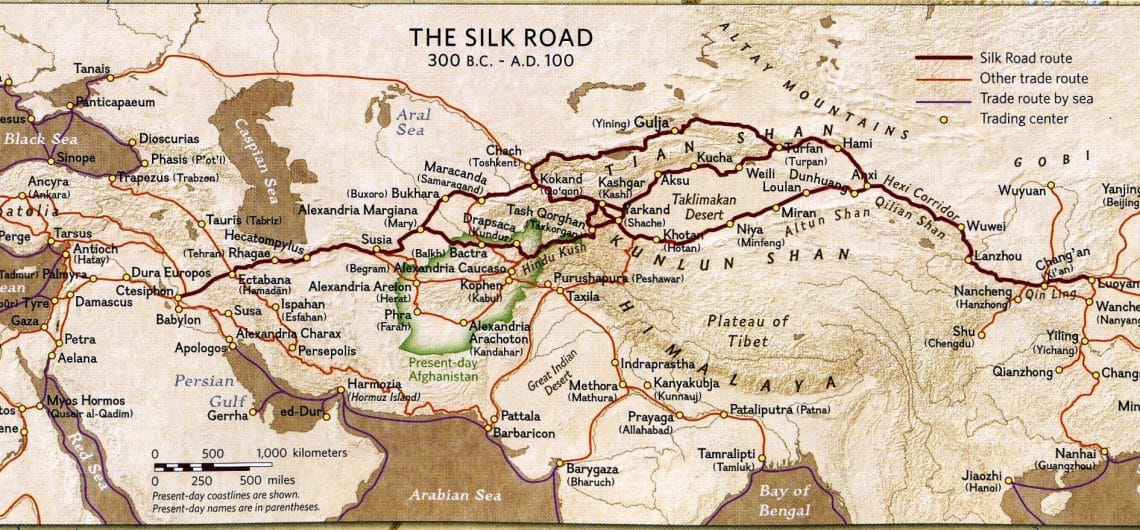THE SILK ROAD
The Silk Road is an ancient caravan trail that stretches from East to West. From China through India, Asia Minor, ancient Mesopotamia, Egypt, the African continent, Greece and Rome, and finally to Britain.
I have always been fascinated by the Silk Road. I am sure that the reality was very tough but I think of a glamorous version of Lawrence of Arabia. Images of evocative and romantic journeys through deserts and mountains.
By and large a means of transporting rare and precious silk from China to Europe, the Silk Road finally became so much more. Many types of merchandise were traded along the Silk Road. In fact, Mesopotamia (present day Iran) became China’s closest trading partner. Paper, which had been invented during the Han Dynasty, and gunpowder, also a Chinese invention, had a greater impact on culture than silk.
The rich spices of the east, also, contributed more than the fashion which grew up from the silk industry. Even so, by the time of Emperor Augustus, trade between China and the west was firmly established and silk was the most sought after commodity in Egypt, Greece, and, especially, in Rome.
The greatest value of the Silk Road was the exchange of culture. Art, technology, philosophy, religion, language, science, architecture, and knowledge were exchanged along with the commercial goods. This was the first stage of globalisation and had the unfortunate side effect of being the perfect way to spread disease. Hence, the bubonic plague, is thought to have arrived in Constantinople via the Silk Road. The epidemic virtually decimated the Byzantine Empire.
SILK ROAD IN ANATOLIA
Due to its central position Turkey played an integral part along the Silk Road. There are still many well-preserved Caravanserais scattered throughout Turkey.
In the North the Silk Road ran through: Trabzon, Gümüşhane, Erzurum, Sivas, Tokat. To Amasya, Kastamonu, Adapazarı, Izmit, Istanbul and Edirne.
Mardin, Diyarbakır, Adıyaman, Malatya, Kahramanmaraş, Kayseri, Nevşehir, Aksaray, Konya, Isparta, Denizli, Antalya featured in the southern sections.
In central Anatolia, Erzurum, Malatya, Kayseri, Ankara, Bilecik, Bursa, İznik, İzmit, Afyon. Most trails ended up in Istanbul.
Along with cuisine, Turkey has gained many traditions and cultures through the Silk Road.
Nevruz
Nevruz marks the New Year and the beginning of spring across much of Asia. It is celebrated on 21 March every year. Traditions include leaping over fires and streams, tightrope walking and leaving lit candles in house doors. Games such as horse racing or the traditional wrestling also take place.
Turkish coffee culture
Turkish coffee has rich traditional culture, preparation and brewing techniques. The beans are roasted in a traditional coffee pan. Ground into a powder then brewed in copper pots (cezve). It is served in tiny cups, with a glass of water and Turkish delight. Therefore Turkish coffee is considered a great symbol of hospitality. The grounds left in the empty cup are also used to tell a person’s fortune.
Ebru
Ebru is the traditional Turkish art of creating colourful patterns by mixing paint into oily water and then transferring the patterns to paper. Known as marbling, the designs include flowers, foliage, latticework, mosques and moons. The art is then used for decoration in the traditional art of bookbinding.
 Seljuk Caravanserais
Seljuk Caravanserais
The institution of caravanserais have their origins in the nomadic lifestyles of the Turkish tribes of Central Asia. Travellers and their animals would have food and a place to sleep. These establishments were built approximately 30 kilometres apart. This could be covered in 8-10 hours. The time it would take the normal speed of a caravan. Regardless of their religion, language or race, travellers were welcomed for three days. Their animals were taken care of and fed, and the sick were cured. All at the expense of the foundation.
One day I will travel the Silk Road. Until then visions and dreams of ancient routes will have to quench my thirst.



Comments